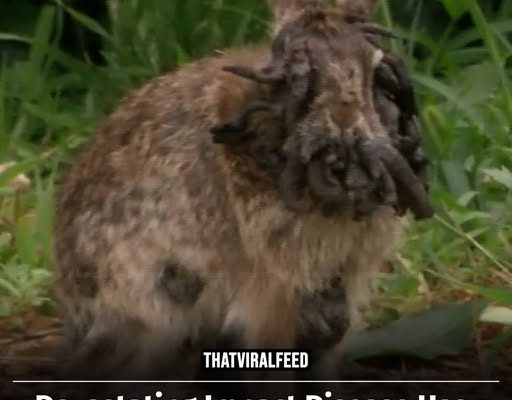Okay, I’ll admit that might not be the most graceful analogy, but the truth is, what’s happening to these rabbits is just as unsettling as it sounds.
Recently, images of a so-called ‘Frankenstein’ rabbit made the rounds online, shocking thousands. But contrary to what some might imagine, this wasn’t the work of a mad scientist throwing a lever during a lightning storm to create a monster in some creepy lab tower.
These rabbits are suffering from cottontail rabbit papilloma virus (CRPV), also known as Shope papilloma virus. It’s an oncogenic DNA virus that’s most commonly spread by mosquitoes and ticks when they bite the rabbit’s skin, though other biting insects can play a role too.
In simple terms, this virus triggers the growth of tumors on the rabbit’s skin. In severe cases, it can even lead to a specific type of cancer known as squamous cell carcinoma, making the illness not just strange-looking but seriously dangerous.
What is the impact of cottontail rabbit papilloma virus?
This virus can be deadly for rabbits if they catch it. While some may recover within a year, others face a slow and painful decline that can stretch over months.
The real danger comes when the horn-like warts begin to grow around a rabbit’s mouth and eyes. Over time, these can block their vision, leading to blindness, and prevent them from eating properly, which can ultimately cause starvation.
Although insects like ticks and mosquitoes are the most common carriers, the virus can also spread directly between rabbits. Sharing food or water bowls, or even bedding, can give it an easy route from one animal to another.

What do authorities say about the papilloma virus?
According to Colorado Parks and Wildlife (CPW), these tumors don’t usually harm a rabbit unless they’re growing in places that block vital functions, like around the mouth or eyes.
“The growths have no significant effects on wild rabbits unless they interfere with eating/drinking. Most infected cottontails can survive the viral infection, after which the growths will go away.” it writes.
Even though humans can’t catch this virus from rabbits, CPW strongly advises people to keep their distance from any animal that looks infected, just to be safe and avoid unnecessary contact.
The ‘jackalope’
With their odd horn-like growths, these infected rabbits have drawn comparisons to the legendary ‘jackalope’ — a mythical jackrabbit said to have antelope horns.
For years, schoolkids across America have been told this creature was nothing but a tall tale, a fun piece of folklore. But perhaps there was a grain of truth hidden in the legend. After all, the CRPV virus was first identified in Midwestern America back in 1933 by scientist Richard E. Shope.
That’s why when Suzanne Peurach from the US Geological Survey Patuxent Wildlife Research Center came across a rabbit with these strange growths inside a box, she was stunned and could hardly believe her eyes.

“Those are fake animals, the result of people sewing taxidermy rabbits and deer antlers together. This rabbit was definitely not one of those.”



